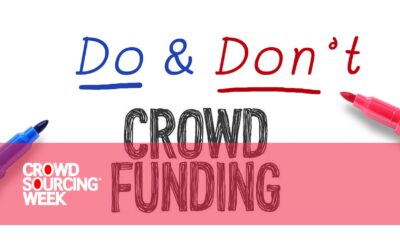Editor’s note: This is the first of a three-part blog series of tips for executing a successful equity crowdfunding campaign.
Experience is one of the best teachers. A few weeks ago Crowdsourcing Week wrapped up our first ever equity crowdfunding campaign on Crowdcube. Although we didn’t meet our investment goal, we learned a TON during the process and so I asked my team members to share their insights and feedback here that might be helpful to others preparing their campaigns.
Crowdfunding is fun and exciting, but it also requires hard work and a bold attitude to go the extra mile. It cannot be overemphasized how important it is always to try new things, fail quickly, and learn from the mistakes so we can turn them into opportunities.
I learned that cautious optimism is an indispensable attitude when launching an equity crowdfunding campaign. Below are three valuable lessons sourced from our team based on first-hand experiences in executing it. Along the way, we had the opportunity to discover the gaps and systems we can improve as a team, had a chance to test the current market, and learned how to deal quickly with uncontrollable external factors as they arose.
#1) Preparation is the key
Benjamin Franklin once said, “If you fail to plan, you are planning to fail!” We couldn’t agree more. Depending on the equity crowdfunding platform you use, the approval process could take at least 3-4 weeks before you can go live. Unlike on a reward-based platform like Kickstarter, you can’t just upload the information on the platform and days later you are approved.
While we were geared up with the necessary documents, files, spreadsheets, etc. especially our lists of contacts and network, we discovered we should have had allotted more time for the formal vetting and approval process, during which the equity crowdfunding platform’s legal team will vet and verify all of the information in the pitch and business plan, before clearing your offering for launch. This is a standard process due to the equity investment nature of the offering, and you should allot a few weeks for it in your campaign schedule.
Key Takeaway: Expect the unexpected on any campaign, work closely with your contact person on the platform, and expect it to take at least three weeks after you’ve loaded your pitch into the platform before it will go live. Always remember that to a certain extent, the timeframe of your campaign will not be completely in your control, and plan accordingly.
#2) The clarity of WHY
Prospective investors want to know the why. This is not the gushy-mushy-stuff of because you want to save the entire universe that’s why you’re in business. What investors need are solid facts and numbers for how much funding you need and where it will be applied and why, along with a technical and practical explanation of your vision. If the why isn’t clear, it will be hard to translate that into investments.
Key takeaway: Explain the business model using layman terms and walk them through your vision. Avoid the jargon and phrases you use in you industry and talk in their language. Perhaps, you will find investors who are not familiar with your industry but believe in your credibility and your vision. Consider the “why” as gasoline to accelerate. A car (your business) can’t move without it, right? The “why” has an emotional or relational knack. It can’t be measured or analyzed, but it resonates with the community’s hearts and passion, however, when it comes to equity crowdfunding it’s all about feasibility, equity shares, and ROI.
#3) Weave the WHY into a compelling story
If the why is vague, it will be tough to weave it into a compelling story. Our COO and equity crowdfunding authority Paul Niederer always emphasizes its importance when launching a campaign. It’s not so much WHAT you say but HOW you say the WHY. One of the important elements is the creative marketing and if there are natural storytellers in your team, capitalize on their talents and weave their ideas into short stories and testimonies.
Paul recommends the pitch video to focus on a brilliant story about why the community should get involved; the rewards are not a driver if the fundamental raise story doesn’t sell.
Key takeaway: Aside from the pitch video, you can take a few rolls on some teasers and snippets throughout the campaign to maintain the momentum and increase the virality. Here’s the truth: stories convert. So write a good one.
I’ll share our team’s next four equity crowdfunding lessons in another blog post that will focus on the importance of communications, media and marketing of your campaign. So stay tuned!





0 Comments